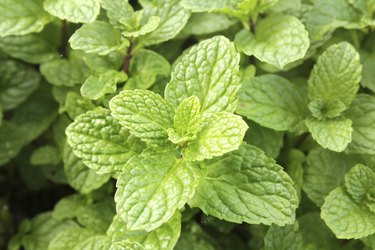
Native to Europe, mint -- a family of plants whose prominent members include spearmint and peppermint -- is grown throughout the United States. Like other herbs, mint leaves offer a healthful way to flavor your meals, without having to resort to fatty or sodium-laden seasonings, which can pose risks to your health. Use mint in a variety of dishes to reap the benefits of its rich nutritional profile.
Nutrition Basics
Video of the Day
Mint leaves are very low in calories -- a 1/4-cup serving of fresh peppermint contains only 4 calories, while an equivalent serving of spearmint provides just 10. Fresh mint leaves contain negligible amounts of protein and fat, and provide small amounts of carbohydrates. A serving of peppermint offers 1 gram of total carbohydrates -- including 0.5 grams of fiber -- while spearmint contains 2 grams of carbohydrates per serving, including 1.6 grams of fiber. The fiber in mint leaves offers health benefits, including helping to reduce cholesterol levels and lowering your risk of obesity.
Video of the Day
Vitamin Content
Mint leaves provide a considerable amount of vitamin A, as well as small amounts of other vitamins. Vitamin A promotes healthy skin and supports your immune system -- and also helps cells reproduce normally. Spearmint is high in vitamin A. Each 1/4-cup serving contains 924 international units, and provides 40 percent of the daily vitamin A intake recommendation for women and 31 percent for men, established by the Institute of Medicine. Mint also provides small amounts of vitamin C and B-complex vitamins, although it doesn't serve as a significant source of these nutrients.
Mineral Content
Spearmint, but not peppermint, also serves as a good source of minerals. It's high in iron, at 2.7 milligrams per serving, and provides 15 percent of the iron intake requirements for women and 34 percent for men, according to the Institute of Medicine. Spearmint also contains manganese -- approximately 11 percent of the daily requirement for men and 14 percent for women. Manganese supports healthy brain function and aids in the production of sex hormones, while iron helps provide cells with oxygen and aids in energy production.
Uses for Mint Leaves
The fresh and crisp flavor of mint leaves complements a range of dishes. Garnish steamed green peas and carrots with shredded spearmint, or mix chopped peppermint leaves with arugula, unsweetened dried cranberries and toasted pecans for a healthful salad. Add a few fresh mint leaves to your favorite smoothie -- a mixture of nonfat milk, Greek yogurt, frozen banana, cacao powder and peppermint makes for a delicious high-protein chocolate mint smoothie. Alternatively, steep fresh mint leaves in hot water for peppermint or spearmint tea, or steep them in ice water for all-natural flavored water.
- Purdue University: Peppermint
- USDA National Nutrient Database: Peppermint, Fresh
- USDA National Nutrient Database: Spearmint, Fresh
- McKinley Health Center: Macronutrients: the Importance of Carbohydrate, Protein, and Fat
- University of Maryland Medical Center: Iron
- University of Maryland Medical Center: Manganese
- University of Maryland Medical Center: Vitamin A (Retinol)
- Purdue University: Spearmint